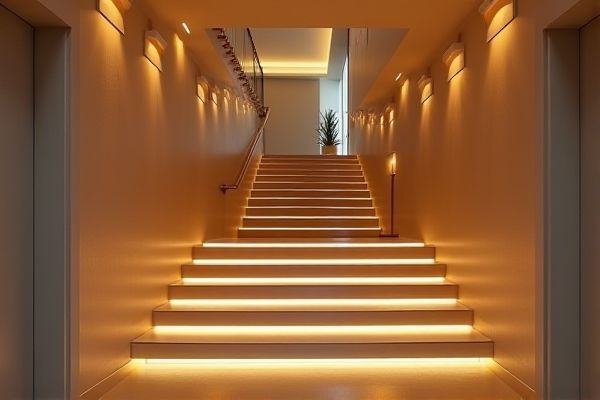
Staircase lighting focuses on safety and visibility by illuminating each step to prevent accidents, while hallway lighting aims to provide even, ambient illumination for navigation and aesthetic appeal. Discover how optimizing Your lighting choices can enhance both functionality and design throughout your home in the full article.
Table of Comparison
| Criteria | Staircase Lighting | Hallway Lighting |
|---|---|---|
| Purpose | Enhance safety on stairs, prevent trips and falls | Illuminate corridors for clear visibility and navigation |
| Light Intensity | Moderate to bright, focused on steps | Even and consistent across the hallway |
| Light Placement | Step edges, handrails, or under treads | Ceiling-mounted fixtures or wall sconces |
| Lighting Type | LED strips, recessed lights, motion sensors common | Flush mounts, pendant lights, or recessed lighting |
| Design Focus | Functionality and safety, with aesthetic accents | Functional illumination with style and flow |
| Energy Efficiency | Often uses low-energy LED for longer use | Varies, but LED preferred for longevity and efficiency |
| Control Methods | Motion sensors, timers, manual switches | Manual switches, dimmers, automated systems |
| Installation Complexity | Moderate; wiring near stairs needs caution | Standard; easier ceiling or wall fixture installation |
| Safety Impact | Critical to prevent stair accidents | Helps avoid collisions and tripping in hallways |
Introduction to Staircase and Hallway Lighting
Staircase lighting enhances safety by illuminating steps and reducing trip hazards, often using LED strip lights or recessed fixtures. Hallway lighting ensures clear visibility and comfortable navigation through corridors, frequently employing wall sconces or ceiling-mounted lights. Both lighting types prioritize functionality and ambiance but differ in placement and intensity to suit their specific architectural features.
Importance of Proper Lighting in Transitional Spaces
Proper lighting in staircases and hallways enhances safety by reducing the risk of trips and falls in these transitional spaces. Staircase lighting requires targeted illumination to highlight each step clearly, while hallway lighting needs to create a uniform brightness to guide movement smoothly. Optimized lighting design in these areas improves visibility and adds to the overall aesthetic appeal of a home or commercial building.
Key Differences Between Staircase and Hallway Lighting
Staircase lighting prioritizes safety by providing focused illumination on steps to prevent trips and falls, often using LED strip lights, step lights, or motion-sensor fixtures. Hallway lighting, on the other hand, is designed to evenly light a broader space for navigation and ambiance, typically featuring ceiling-mounted fixtures, sconces, or recessed lights. Your choice should consider the specific function and spatial layout, as staircase lighting requires targeted brightness while hallway lighting demands overall consistency.
Safety Considerations: Stairs vs. Hallways
Staircase lighting requires higher illumination levels and focused placement to prevent trips and falls on steps, where uneven surfaces pose greater safety risks compared to hallways. Hallway lighting prioritizes uniform brightness to ensure clear visibility along flat walking paths, reducing the chance of collisions or obstructions. Properly designed lighting systems for stairs often include step lights and handrail illumination, while hallways benefit from widespread ambient lighting and motion sensors for optimal safety.
Design Aesthetics and Ambience Impact
Staircase lighting enhances design aesthetics by highlighting architectural details and creating focal points that add depth and dimension to your space. Hallway lighting impacts ambience by providing uniform illumination that ensures safety while maintaining a welcoming atmosphere throughout transitional areas. Both lighting types influence mood and style, with staircase lighting offering dramatic effects and hallway lighting delivering consistent brightness.
Lighting Fixture Options for Staircases
Staircase lighting options include recessed lights, wall sconces, LED strip lights, and pendant fixtures designed to enhance safety and aesthetics. Recessed lights installed along stair risers or under handrails provide subtle illumination, while wall sconces mounted at regular intervals offer consistent brightness. LED strip lights integrated into stair treads or beneath railings create modern, energy-efficient lighting that highlights each step.
Popular Hallway Lighting Solutions
Popular hallway lighting solutions include recessed ceiling lights, wall sconces, and LED strip lights, which provide even illumination and enhance safety. Staircase lighting often incorporates step lights or handrail-integrated LEDs to highlight each tread and prevent falls. Your choice between hallway and staircase lighting depends on balancing aesthetic appeal with functional visibility for safe navigation.
Energy Efficiency and Smart Controls
Staircase lighting typically utilizes focused LED fixtures and motion sensors to enhance energy efficiency by illuminating only when movement is detected, reducing unnecessary power consumption. Hallway lighting often involves broader ambient light with dimmable smart controls, allowing you to adjust brightness based on natural light or occupancy patterns for optimal energy savings. Integrating smart controls in both settings ensures automated operation, lowering electricity costs while maintaining safety and convenience.
Installation Challenges and Maintenance
Staircase lighting often requires precise installation to ensure safety and compliance with building codes, involving wiring along stair edges or under handrails, which can be more complex than hallway lighting setups. Hallway lighting installations generally offer more flexibility with ceiling or wall-mounted fixtures, simplifying access for electrical connections and routine maintenance. Your choice should consider that staircase lighting demands more frequent inspection and potential bulb replacement due to higher safety importance, while hallway lighting typically experiences less wear and easier upkeep.
Choosing the Right Lighting for Your Space
Staircase lighting enhances safety and highlights architectural features with focused, step-level illumination, while hallway lighting provides broad, ambient light for clear visibility and seamless navigation. Selecting energy-efficient LED fixtures tailored to the dimensions and purpose of each area ensures optimal brightness and reduced power consumption. Prioritizing adjustable brightness and color temperature helps create a cohesive atmosphere that complements both staircases and hallways effectively.
 homyna.com
homyna.com